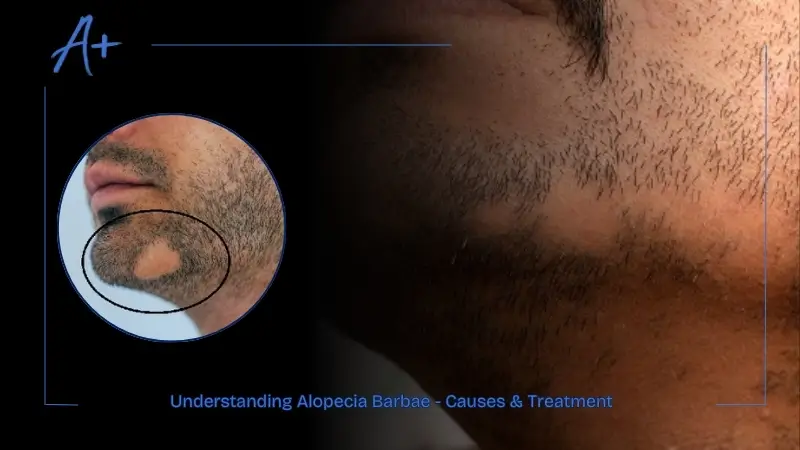
Hair loss is a normal phenomenon and part of the natural shedding cycle. However it becomes a major concern when bald patches appear, indicating an underlying medical condition.
Alopecia can be mentally challenging for both men and women. This is especially true for those who rely on their physical appearance such as celebrities or individuals for whom it is a major part of their identity.
In this article, we will explore the causes of alopecia barbae and how it can be differentiated from other medical conditions. We will also discuss different treatment options, including medications, home remedies and special techniques.
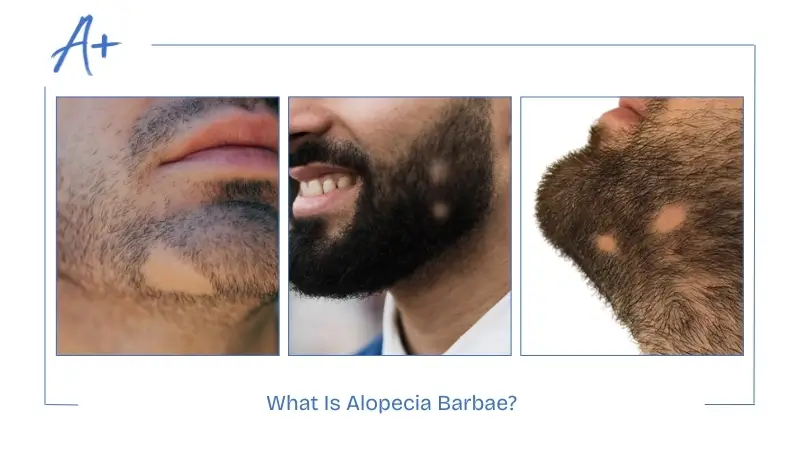
‘Alopecia’ means hair loss and ‘barbae’ means beard. This specific type of hair loss affects beard hair, causing bald patches or hair thinning in the beard area.
It is a form of alopecia areata, an autoimmune condition causing hair loss. In autoimmune conditions, the body’s immune system attacks its own cells and tissues instead of protecting them.
What Are The Causes Of Alopecia Barbae?
The specific causes of alopecia barbae are unknown. It is related to multiple factors occurring together to cause hair loss due to this autoimmune condition. Some of these factors include:
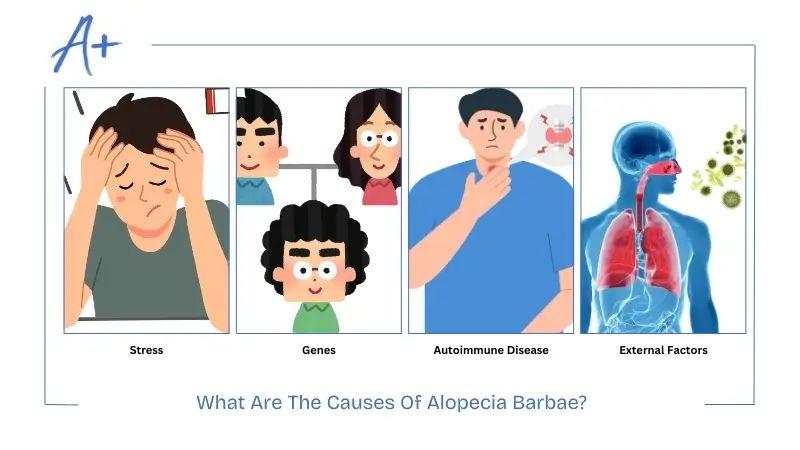
- Stress: Physical, mental, psychological stress have been linked to hair loss, especially this type.
- Genes: A family history of alopecia, asthma or allergies can make you prone to it.
- Autoimmune Disease: Conditions like Type 1 Diabetes, lupus and psoriasis can make you more prone to another autoimmune disease.
- External Factors: Certain viruses, substances and medications can trigger the immune system, leading to increased hair loss.
What Are The Signs & Symptoms Of Alopecia Barbae?
Some people may already struggle with growing thick beards. This condition can lead to increased difficulty in growing beard hair. Alopecia barbae can cause the following signs and symptoms:
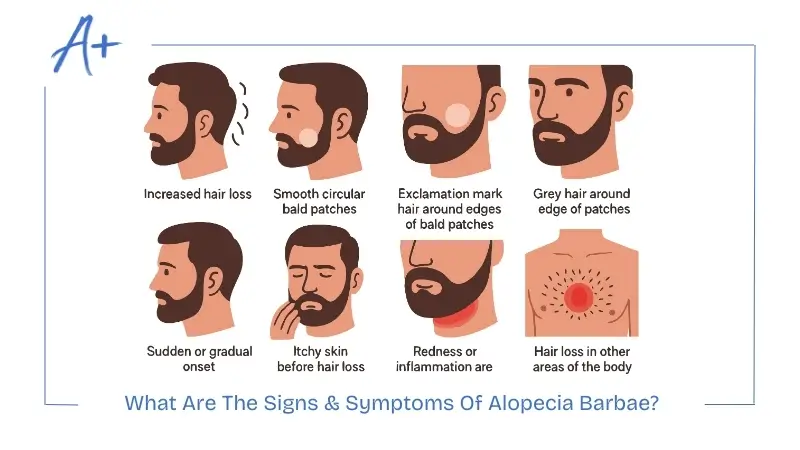
- Increased hair Loss
- Smooth circular bald patches
- Exclamation mark hair around edges of bald patches
- Grey hair around edge of patches
- Sudden or gradual onset
- Itchy skin before hair loss
- Painful skin in affected area
- Redness or inflammation in the area
- Hair loss in other areas of the body
How Is Alopecia Barbae Diagnosed?
Alopecia barbae is relatively easy to diagnose based on its signs and symptoms alone. Your doctor can follow these steps to make a diagnosis:
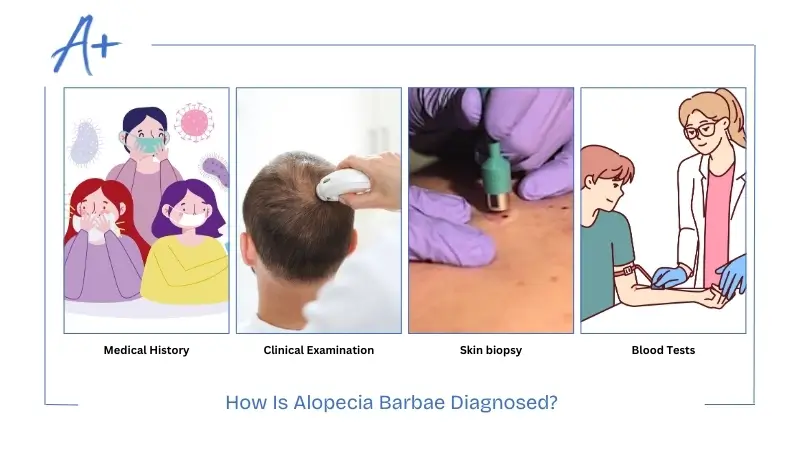
Medical History
Understanding your medical background is necessary for diagnosing and treating alopecia barbae effectively.
-
- Symptomatic History: The doctor will ask about your hair loss, when it started, what makes it worse and any other symptoms.
- Family History: Knowing your family history of any autoimmune condition is important as it increases the likelihood of alopecia.
- Medication Review: Your doctor will inquire about your medication history to rule out any triggers.
- Environmental factors: Checking for any hidden environmental factors that could trigger your condition is crucial.
Clinical Examination
A thorough clinical examination helps accurately assess the condition of your hair and scalp.
-
- Inspection: The doctor will examine your bald patches to identify the pattern and severity of hair loss and any skin changes.
- Trichoscopy: Your dermatologist may use a microscope to examine your hair and scalp at high magnification. They may take hair samples from the edges of bald patches.
Skin biopsy
To rule out other conditions like fungal infection or other types of alopecia, your doctor may take a skin sample from your scalp or your beard to examine under a microscope.
Blood Tests
These tests can help to rule out other conditions or causes of hair loss. Examples of underlying medical conditions causing hair loss include thyroid and other autoimmune diseases, which can be detected using blood tests.
Role OF Trichoscopy In Alopecia Barbae
Trichoscopy can help in diagnosing alopecia barbae, differentiating it from other types of hair loss and monitoring treatment response.
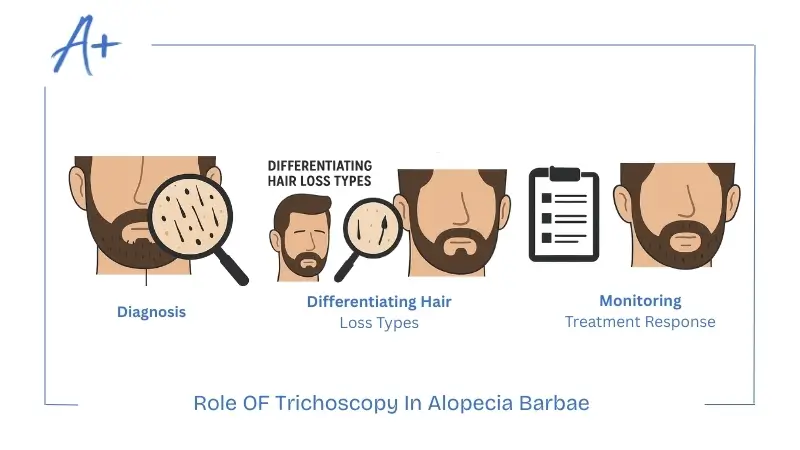
Diagnosis
These examination findings can help to differentiate alopecia barbae from other types of hair loss. Key features of alopecia barbae from trichoscopy include:
-
-
- Yellow Dots: These are the follicular openings which contain sebum and degenerating cells, a common finding in alopecia areata.
- Black Dots: They represent broken hairs where the hair shaft breaks from the follicle.
- Broken Hair: Short hairs may be visible.
- Exclamation Mark Hair: Characteristic of alopecia areata, these hairs taper down towards the follicle, being thicker at base and tapering to a point.
- Short Vellus Hair: These are fine delicate hair that can easily break.
-
Differentiating Hair Loss Types
Trichoscopy helps differentiate alopecia barbae from other types of hair loss such as trichotillomania and telogen effluvium which have different findings. Accurate differentiation is important for planning appropriate medication and treatment.
Monitoring Treatment Response
Trichoscopy can monitor treatment response by tracking changes in hair and skin over time. This aids in planning and changing your treatment plan according to the response notes.
How To Treat Alopecia Barbae?
Treatment options for alopecia barbae depend on the severity and extent of the disease. This typically follows the confirmation of diagnosis after ruling out other conditions.
First, know that there is no cure for alopecia barbae but it can be managed to stop or decrease hair loss and thinning. The main aim of treatment is to block the immune system attacking the hair follicles and to promote hair growth.
There is no one solution that fits all. It requires time and trials of different medications to find the best solution for you. Treatments are usually more effective if significant hair loss, typically less than half, has not yet occurred.
Medications
Medications can promote hair growth, each with its own mechanism of action. Some products are over the counter, while others require a doctor’s prescription.
-
-
- Steroids: These immunosuppressants block the body’s immune system and cells attacking the hair follicles. They are usually given as injections or applied topically.
- Minoxidil: While its full mechanism is not fully understood, minoxidil is believed to increase blood flow around hair follicles, stimulating hair growth. It is used as a topical liquid or foam and can treat genetic baldness. Results may be visible in three months or more.
- Diphencyprone: This topical immunotherapeutic agent works by causing an allergic reaction on the skin, moving immune cells away from the hair follicles. This can cause redness, swelling and itching but is an effective treatment for alopecia areata and barbae.
- Anthralin: This topical medication causes localized inflammation, stimulating hair follicles, similar to diphencyprone. Both should be used under a dermatologist’s guidance due to potential side effects.
-
Latest Treatment Techniques
Apart from medications, some treatment options are available and performed by medically trained professionals:
-
-
- Platelet Rich Plasma: Blood is taken from the patient, centrifuged to separate plasma and then injected into the scalp to stimulate hair follicle cells. It shows promising results but requires multiple sessions for full effects.
- Microneedling: Commonly used for anti ageing skin treatment, it can also help with hair loss by creating small punctures in the skin, helping in new hair growth.
- Beard Transplant: If medications and other treatments fail, consider a beard transplant. Using the Follicular Unit Extraction (FUE) technique, it restores the beard density with natural lifelong results.
-
How To Fix Bald Spots On A Beard With Home Remedies?
Home remedies are a controversial topic, as there is limited scientific evidence to support their effectiveness. However, many cultures and traditions have supported their efficacy that are still believed by many.
There is usually no harm in trying remedies using natural ingredients available at home or in the market as long as you do not experience any allergy symptoms.
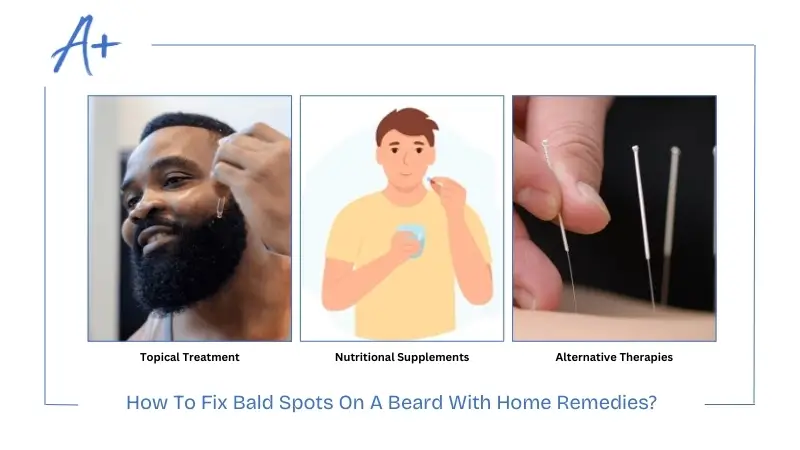
Topical Treatment: Some home remedies that can be used for bald patches of beard include gently rubbing any of the following options:
-
-
- Garlic juice
- Fish oil
- Almond oil
- Castor oil
- Coconut oil
- Lavender oil
- Onion juice
- Aloe vera
- Rosemary oil
-
Nutritional Supplements: Some people take nutritional supplements such as zinc, iron or biotin tablets and report increased hair growth and improved hair health.
Alternative Therapies: Other alternative therapies that can help in improving hair growth are acupuncture or aromatherapy, however, there is no scientific evidence for it yet.
How Long Does It Take To Recover From Alopecia Barbae?
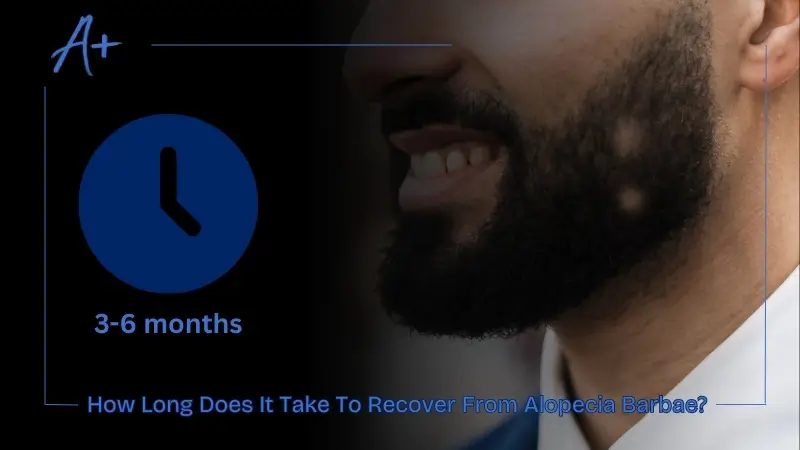
There is no simple and definite recovery time for alopecia barbae. It depends on the level of hair loss and response to treatment.
For low levels of alopecia and small patches of beard loss, some treatments can show effect in 3-6 months. But some treatments may take longer and require 12 or more months to see results.
Frequently Asked Questions
Can hair grow back after alopecia barbae?
Yes, your beard hair can grow back. Alopecia barbae is a type of alopecia areata, a non scarring hair loss condition. This means the hair follicles are not permanently damaged and can grow hair again. While it can spontaneously resolve, some treatments can help speed up this process.
What flares up alopecia?
Some known triggers which can flare up alopecia, including:
- Stress
- Medications
- Hormonal changes
- Diet changes
- Physical trauma
What helps alopecia grow back?
Alopecia can be reversed using certain medications or treatment options, including:
- Steroids
- Minoxidil
- Diphencyprone
- Anthralin
Other treatment options include PRP, microneedling and transplants.
Does stress cause alopecia barbae?
Yes, both physical and psychological stress can cause alopecia barbae. But usually these triggers affect susceptible individuals who already have a genetics or family history of autoimmune conditions.
Can alopecia barbae spread?
Yes it can spread to other areas or the bald patches can enlarge. It is caused by an autoimmune condition, alopecia areata. This condition can get worse due to triggers such as stress and certain medications which can cause spread of these bald patches.

